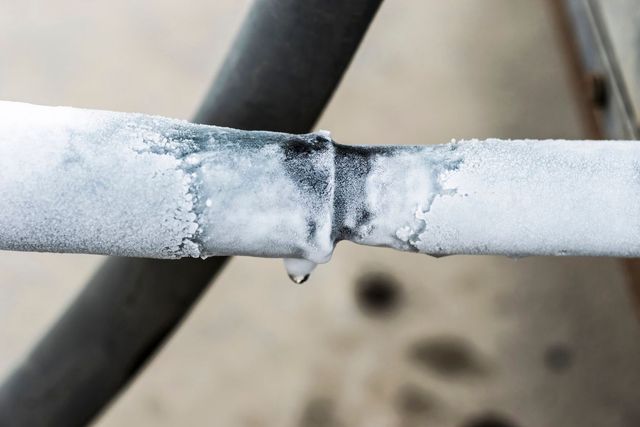How to Handle a Frozen AC Pipe - Critical Measures for Restoration
How to Handle a Frozen AC Pipe - Critical Measures for Restoration
Blog Article
Just about every person seems to have their own individual rationale in relation to Air Conditioner Frozen? How To Fix your Frozen AC Line.

Intro
Finding that your AC pipe is iced up can be concerning, especially during warm summer season when you count on your air conditioning system the most. Comprehending what to do in such a situation is essential to avoid further damage to your air conditioning system and ensure your comfort inside.
Comprehending the Causes
Several variables can add to the cold of an a/c pipe. Comprehending these causes can assist you resolve the issue successfully.
Absence of Airflow
One usual source of a frozen air conditioner pipe is inadequate air flow. When the air movement over the evaporator coil is limited, it can cause the coil to go down below freezing temperature level, resulting in ice formation on the pipeline.
Reduced Refrigerant Levels
Not enough cooling agent levels in your air conditioning system can also lead to a frozen pipeline. Low refrigerant degrees can create the pressure in the system to go down, causing the freezing of moisture on the evaporator coil.
Winter Conditions
In cooler environments, freezing temperature levels outside can contribute to the freezing of air conditioning pipelines. If your air conditioning unit is not properly insulated or if there are leakages in the ductwork, cool air can penetrate the system, creating the pipeline to freeze.
Dirty Air Filters
Dirty or clogged air filters can limit air movement in your AC system, resulting in various problems, including a frozen pipeline. It's necessary to replace or clean your air filterings system routinely to ensure correct air movement and prevent ice build-up.
Indications of a Frozen Air Conditioning Pipe
Identifying the signs of an icy AC pipeline is crucial for prompt activity.
Minimized Airflow
If you notice a considerable decrease in airflow from your vents, it might indicate an icy pipeline.
Ice Buildup on the Pipe
Visible ice buildup on the refrigerant line or the evaporator coil is a clear indication of a frozen air conditioning pipe.
Strange Sounds from the Unit
Unusual audios, such as hissing or bubbling, originating from your air conditioning unit can signal that there's ice present on the pipeline.
Immediate Actions to Take
When faced with an icy AC pipeline, it's necessary to act swiftly to stop further damages to your cooling system.
Turning off the AC
The first step is to turn off your a/c unit to avoid the system from running and intensifying the issue.
Looking for Blockages
Evaluate the area around the interior device for any blockages that may be blocking airflow, such as furnishings or curtains.
Thawing the Pipe
You can use gentle methods like positioning towels taken in warm water around the icy pipe to aid thaw it gradually.
Safety nets
Taking preventive measures can help prevent future incidents of an icy air conditioner pipe.
When DIY Methods Fail
If your efforts to thaw the pipe or address various other problems are not successful, it's time to employ a professional.
Relevance of Hiring a Professional HVAC Technician
A licensed HVAC technician has the experience and tools necessary to identify and repair problems with your a/c system securely and effectively.
Routine Maintenance Checks
Schedule normal maintenance talk to a specialist HVAC technician to ensure that your air conditioner system is running effectively.
Altering Air Filters
Consistently replace or cleanse your air filters to stop air flow limitations and preserve optimal performance.
Protecting Exposed Pipes
If your AC pipes are revealed to chilly temperature levels, think about shielding them to avoid cold during cold weather.
Looking For Professional Help
If DIY techniques stop working to resolve the concern or if you're unclear concerning just how to continue, it's finest to look for support from a qualified HVAC technician.
Verdict
Dealing with an icy air conditioner pipeline can be a discouraging experience, yet recognizing exactly how to respond can aid decrease damage and restore comfort to your home. By recognizing the causes, acknowledging the signs, and taking timely action, you can successfully attend to the concern and avoid future occurrences.
Frozen AC Line: Why It Happens & What To Do About It
A frozen AC line can be a rather peculiar sight in a place like Phoenix, Arizona where nothing ever freezes. In this post, we’ll discuss what makes an air conditioner line frozen – and what you can do about it.
Dirty Air Filters
Did you know that you should be cleaning or replacing your air filters on a monthly basis? Failing to do this can result in airflow issues that, in turn, cause your evaporator coils and lines to freeze over. You’ll notice a buildup of ice on both components, although the buildup on your pipes will, of course, be more evident unless you open your air condition up to reveal the coils.
What To Do About It
Give your air filter a good cleaning if it’s reusable. If not, replace the filter outright. Next, switch your air conditioner’s fan setting on and leave it there for 2-3 hours. This will draw warm air in, helping to thaw your evaporator coil. You can also check out this article for some tips on cleaning the coils themselves if you’d like to speed the process up. Before you switch the unit back to its normal state, make sure the supply vents are completely unobstructed and free of dust or other debris.
If you keep having this issue even after replacing your filters regularly, contact a local HVAC repair company and have them inspect your evaporator coil, ductwork, and any other components that may be at fault. If you live in the Phoenix, Arizona area, give American Home Water and Air a call.
Low Refrigerant Levels/Leakage
What To Do About It
Contrary to what air conditioner “recharge” companies often tell their clients about refrigerant, it should never need to be simply refilled. You see, refrigerant runs in what experts refer to as a “closed loop.” Refrigerant really shouldn’t be leaving that loop. If it is, you’ve got a leak.
Paying someone to come and pump more refrigerant into your system (aka “recharge” it) isn’t the solution. Doing that will simply kick the can down the road. Besides, refrigerant leaks can be harmful to the environment and people in your home.
Rather, you need to take care of the leak with the help of a technician. Check out this article for some more information about dealing with air conditioners that are leaking refrigerant. Before you contact a technician, switch your thermostat to the off position. Then, switch the fan setting on and let it run for 2-3 hours so the unit can thaw.
Improper Temperature Setting
Improper temperature settings can also cause a drop in your air conditioner’s pressure. What many people don’t realize is that air conditioners are actually designed to run when temperatures have fallen above roughly 60 degrees Fahrenheit. If you run the unit when it’s cold outside, you’ll run into many issues, including frozen components.

I stumbled upon that blog posting on Air Conditioner Frozen? How To Fix your Frozen AC Line while doing a search on the web. Are you aware of anybody else who is involved in the subject? Why not promote it. Thank you so much for taking the time to read it.
Find Out More Report this page